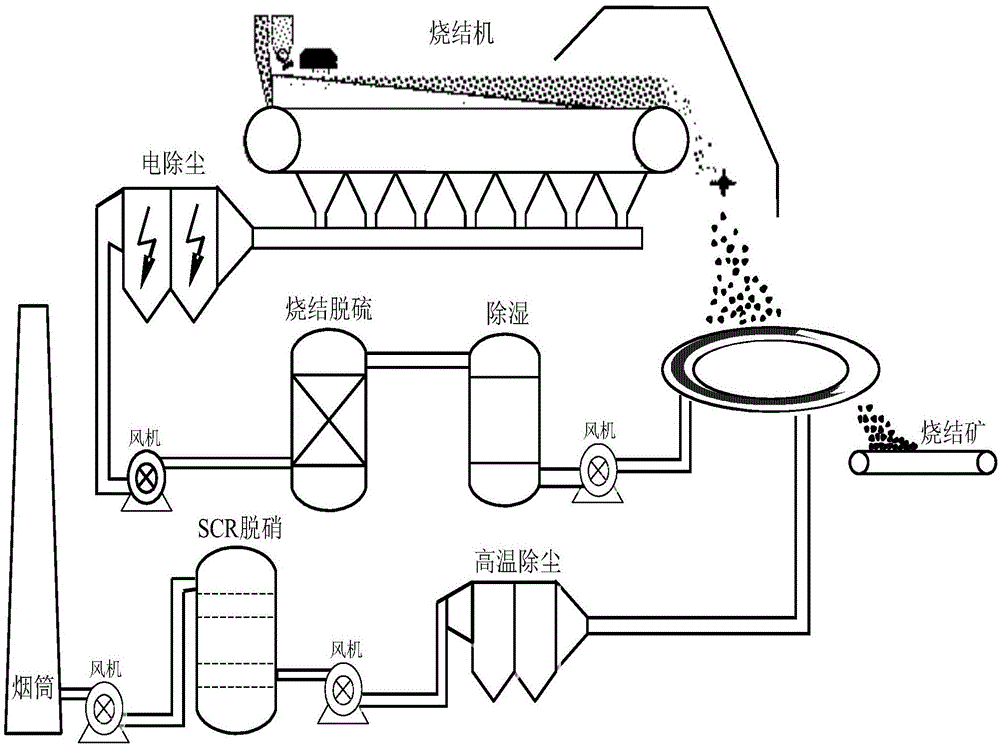Technical method for denitration of sintering flue gas
A technology of sintering flue gas and process method, which is applied in the field of sintering flue gas denitrification treatment process, can solve the problems of little progress, high operating cost, high operating cost, etc., and achieve the effect of strong applicability and reduced operating cost
- Summary
- Abstract
- Description
- Claims
- Application Information
AI Technical Summary
Problems solved by technology
Method used
Image
Examples
Embodiment 1
[0023] The sintering flue gas at 120-130°C is discharged from the desulfurization tower after wet desulfurization, the tail gas temperature is 55-60°C, and the water content is 75mg / m 3 , the steam with high moisture content is dehumidified through the lithium bromide and lithium chloride salt solution contained in the plastic material, and the relative humidity of the flue gas after dehumidification is 20% to 30%;
[0024] During the dehumidification process, the dehumidification solution absorbs the moisture in the tail gas, and its own concentration decreases, and the dehumidification solution is concentrated and regenerated by using the waste heat of the sintering flue gas pipeline at 120-130°C;
[0025] The desulfurized tail gas after dehumidification first passes through the pipeline heat exchanger to exchange heat with the sintering flue gas and sintering ore. After the heat exchange, the tail gas temperature is about 100°C;
[0026] The heat exchange exhaust gas is blo...
Embodiment 2
[0034] The sintering flue gas at 120-130°C is discharged from the dust bag after dry desulfurization, the tail gas temperature is about 90°C, and the relative humidity is about 40%;
[0035] Desulfurization tail gas passed through anhydrous CaCl 2 The dehumidification device further dehumidifies so that the relative humidity is below 20%;
[0036] CaCl 2 Heat release after moisture absorption, tail gas temperature remains at around 90°C after dehumidification, CaCl after moisture absorption 2 Dehydration and regeneration of tail gas after heat exchange by waste heat boiler;
[0037] The heat exchange tail gas is blown in by the fan in the high temperature section of the belt cooler to exchange heat with the sinter, and the sinter in the low temperature section is cooled by natural wind, and a partition wall is added in the belt cooler to prevent the desulfurization tail gas from mixing with the cold air in the low temperature section;
[0038] After the heat exchange, the t...
Embodiment 3
[0045] The sintering flue gas at 120-130°C is discharged from the dust bag after dry desulfurization, the tail gas temperature is about 90°C, and the relative humidity is about 40%;
[0046]The heat exchange tail gas exchanges heat with the sinter through the vertical tank type sinter cooling device. After the heat exchange, the temperature of the desulfurized tail gas is above 320°C. The cold air is cut into the vertical tank to continue cooling the sinter to below 100°C, and the sinter is discharged and sent to Blast furnace smelting.
[0047] After heat exchange, the tail gas is dedusted by the electric precipitator to make the dust concentration of the flue gas meet the requirements of selective catalytic reduction and denitrification;
[0048] Ammonia vapor is introduced into the denitrification device with built-in catalyst for reduction and denitrification. The removal rate of NOx in the flue gas is above 85%. The reaction equation of selective catalytic reduction and d...
PUM
 Login to View More
Login to View More Abstract
Description
Claims
Application Information
 Login to View More
Login to View More - R&D
- Intellectual Property
- Life Sciences
- Materials
- Tech Scout
- Unparalleled Data Quality
- Higher Quality Content
- 60% Fewer Hallucinations
Browse by: Latest US Patents, China's latest patents, Technical Efficacy Thesaurus, Application Domain, Technology Topic, Popular Technical Reports.
© 2025 PatSnap. All rights reserved.Legal|Privacy policy|Modern Slavery Act Transparency Statement|Sitemap|About US| Contact US: help@patsnap.com



